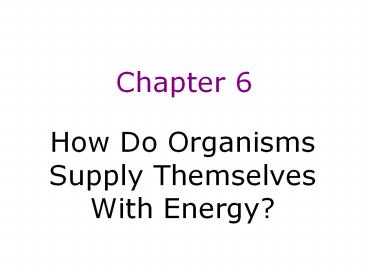How Do Organisms Supply Themselves With Energy? - PowerPoint PPT Presentation
1 / 27
Title:
How Do Organisms Supply Themselves With Energy?
Description:
Cellular respiration converts the chemical energy of food molecules into the ... ATP production from cellular respiration depends on oxidative phosphorylation ... – PowerPoint PPT presentation
Number of Views:64
Avg rating:3.0/5.0
Title: How Do Organisms Supply Themselves With Energy?
1
Chapter 6
How Do Organisms Supply Themselves With Energy?
2
Key Questions
- How do organisms supply themselves with energy?
- How do organisms extract energy from glucose?
- How is the energy in glucose used to make ATP?
3
How Do Organisms Supply Themselves With Energy?
- All organisms need energy
- Ultimate source of energy on the Earth is the sun
- Autotrophs make their own food
- examples plants, some bacteria
- Heterotrophs obtain chemical energy from other
organisms - Examples?
4
Energy Currency
- Adenosine Triphosphate or ATP
- Cellular respiration produces ATP
- Aerobic versus anaerobic
5
Cellular Respiration
6
Steps of Cellular Respiration
- Step 1 glycolysis
- Step 2 acetyl-CoA formation
- Step 3 citric acid cycle
- Step 4 electron transport and oxidative
phosphorylation - Overall equation glucose oxygen carbon
dioxide water ATP
7
Cellular Respiration Chemical Formula
- C6H12O6 6O2
- Glucose Oxygen
- 6CO2 6H2O ATP
- Carbon Water Energy
- Dioxide
8
What Is Oxidation?
- Oxidizing agent or electron acceptor accepts an
electron - Reducing agent or electron donor donates an
electron - Oxidation and reduction always go hand in hand
- Examples of acceptors O2, NAD, FAD
9
Step 1 GlycolysisOccurs in Cytoplasm
- Part 1 6 carbons are split into 3-carbon
molecules and are phosphorylated uses ATP - Part 2 Phosphates and electrons are removed
electrons added to NAD to make NADH produces 2
ATP
10
Step 1 Glycolysis Cont.
- Part 3
- More electrons and phosphates are removed from
the 3-carbon molecules - phosphates are added to ADP to make ATP
11
Glycolysis Overview
- Breaks glucose into 2 molecules of pyruvate,
generating 2 molecules of ATP and 2 molecules of
NADH - Aerobic or anaerobic?
- The pyruvate enters a cells _______.
- When compounds are reduced, they ___ electrons.
- When compounds are oxidized, they ___ electrons.
- Which molecules/coenzymes from Glycolysis accept
electrons?
12
Step 2 Acetyl CoAOccurs in ______
- Oxygen needed for this reaction aerobic
- Pyruvate loses a carbon and 2 oxygens in the form
of CO2 - Enzymes link coenzyme A to the acetate
- CoA synthesizes fatty acids.
13
Step 3 Citric Acid CycleOverview
- High energy electrons are captured in the form of
NADH and FAD - Occurs in the matrix of the mitochondria
- With each turn of the cycle, citrate loses a
total of 8 electrons to electron acceptors such
as NAD
14
Step 3 Citric Acid Cycle
- 3 parts
- Part 1 6-carbon citrate and isocitrate formation
- Part 2 conversion of isocitrate into a 4-carbon
compound - Part 3 production of another molecule of OAA,
which starts the cycle over again
15
Citric Acid Cycle
The acetyl group is oxidized and energy is
captured as ___, ___, ____.
16
What If There Is No Oxygen?
- After glycolysis, if there is no oxygen,
fermentation will occur - Cells must regenerate more NAD from NADH
- Yeast form ethanol (terminal reaction produces
CO2 ) - Animals form lactic acid (ouch)
17
Biochemical Pathway Intersections
Figure 6-7
- Catabolism breakdown of complex molecules such
as food produces energy, involves oxidation - Anabolism synthesis of complex molecules uses
energy
18
How Do Other Food Molecules Enter Metabolism?
- Fat, carbohydrates and proteins enter the
cellular respiration pathway at different points
- The most likely point is at acetyl CoA
19
Electron Transport Chain
20
Step 4 Electron Transport Oxidative
Phosphorylation
- The pathway of electrons from one carrier to
another is called ____ ____ _____ - Each electron carrier passes its electrons to the
next carrier (bucket brigade) - Most of the electrons to the electron transport
chain are received from what cycle? - A reduced carrier becomes oxidized when it gives
up its electrons (forms ATP from ADP) - Oxygen accepts electrons
21
How Do Cells Harvest Energy?
- Proton gradient flow of electrons through the
electron transport chain creates this gradient
(ATP is made from this gradient) - Chemiosmosis harnessing of the energy stored in
the chemical gradient some machinery in the
membrane must do this process
22
Generating a Proton Gradient
- Mitochondria inner and outer membrane
- Intermembrane space space between 2 membranes
- Matrix space w/n the inner membrane makes up
about 2/3 of the volume ETC is embedded in this
inner membrane
23
Pumping Protons
- pH cytochromes assist w/ transport of
electrons. - Gradient is produced when..
24
ATP Synthase
- Proton complex
- Protons flow through these channels back into the
matrix - Works like a turbine
- Uses energy to make ATP
25
Fragments of Inner Membrane
26
Think About This One!
- Why might you lose weight (a lot of weight) if
your mitochondria suddenly lost the ability to
couple electron transport to the production of
ATP?
27
Key Concepts
- Cellular respiration converts the chemical energy
of food molecules into the chemical energy of ATP - Most cells can use glycolysis to obtain energy
- ATP production from cellular respiration depends
on oxidative phosphorylation































